Monstera Deliciosa will thrive outdoors in summer in tropical regions. There are some easy ways to help it to grow well outdoors by making sure they have protection from the afternoon sun, get regular water and are planted in good soil. Leaves that suffer damage should be left on the plant so that they protect the younger, healthy leaves.
This article will explore the best way to grow and protect monstera deliciosa outside in summer.
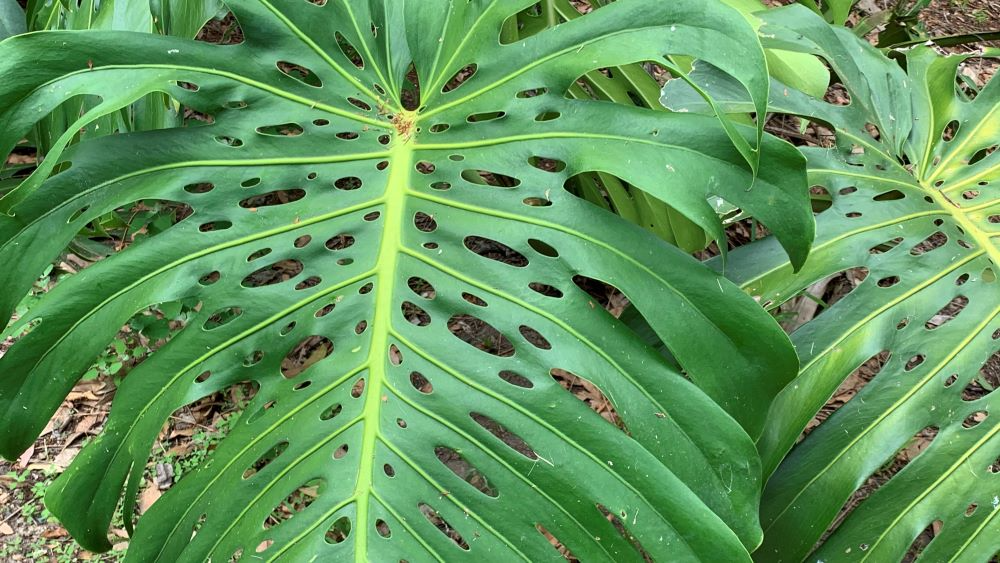
Understanding Monstera Deliciosa
Monstera Deliciosa, also known as the Swiss Cheese Plant, is a popular tropical houseplant that can also be grown outside during the summer months. This plant’s natural habitat is the rainforests of Central and South America and can grow up to 30 feet tall in the wild. It has large, glossy, heart-shaped leaves that develop holes and splits as they mature.
Monstera Deliciosa is a relatively easy plant to care for, but it does have some specific requirements. Here are a few things to keep in mind when growing Monstera Deliciosa outside in the summer:
- Shade is important: Monstera Deliciosa prefers bright, indirect light, but direct sunlight can scorch its leaves. When growing the plant outside, make sure it is in a spot that receives shade in the afternoon.
- Well-draining soil is key: Monstera Deliciosa likes well-draining soil that is rich in organic matter. If the soil is too heavy or compacted, it can lead to root rot.
- Watering should be consistent: Monstera Deliciosa likes to be kept consistently moist, but not waterlogged. Water the plant when the top inch of soil feels dry to the touch.
- Fertilize regularly: Monstera Deliciosa is a heavy feeder and benefits from regular fertilization. Use a balanced, water-soluble fertilizer every two weeks during the growing season.
- Watch out for pests: Monstera Deliciosa can be susceptible to mealybugs, spider mites, and scale insects. Check the plant regularly for any signs of infestation and treat as necessary.
How to Grow Monstera Deliciosa Outside in Summer
Check out my easy tips to successfully grow your Monstera Deliciosa outside in summer.
1. Growing Position
The best place for your outdoor monstera deliciosa in summer is in partial shade. This could be under the protection of overhead trees, verandah or shadehouse. Give monstera a tropical canopy with palms or ornamental gingers to protect the leaves from the direct sun.
You can move indoor plant outdoors in summer to boost their growth. Just make sure they are in a full shade position when you first move them outside. You can then gradually move them out in an area that gets morning sun.

If you live in a region with mild winters and minimal risk of frost, such as USDA hardiness zone 10 and 11, you may be able to grow Monstera deliciosa as outdoor plants year-round with appropriate protection during rare cold temperatures. For most regions of the United States, it is best to grow Monstera deliciosa as a tropical houseplant or a seasonal container plant that can be enjoyed outdoors during the summer.
2. Sunlight Requirements
Monstera Deliciosa plants require bright, indirect sunlight to thrive. Direct sunlight can scorch the leaves, while too little light can cause the plant to grow slowly or not at all.
If you live in a region with intense sunlight, consider placing your Monstera Deliciosa in a spot that receives partial shade during the hottest parts of the day. If you live in an area with mild sunlight, you can place your Monstera Deliciosa in a spot that receives direct sunlight in the morning through until midday or early afternoon.
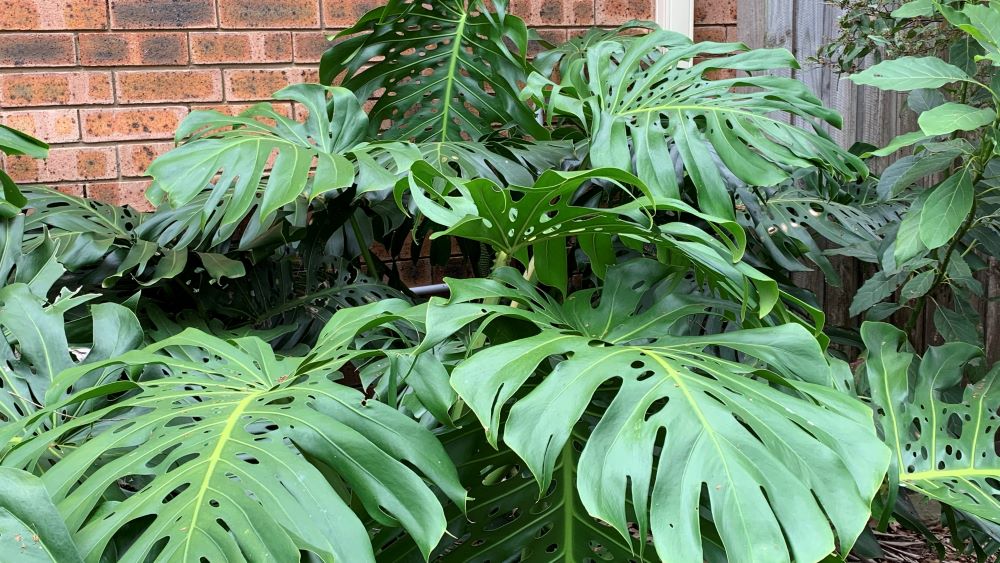
3. Temperature
Monstera Deliciosa thrives in warm temperatures and high humidity. It can tolerate temperatures between 65°F and 85°F, but it prefers temperatures between 70°F and 75°F. If the temperature drops below 50°F, the plant may suffer damage or even die.
If you live in a region with cooler temperatures, consider placing your Monstera Deliciosa in a greenhouse or near a heat source to keep it warm.
4. Prepare the Soil
When growing Monstera Deliciosa outside in summer, it is important to prepare the soil properly. It is recommended to use a well-draining soil mix that is rich in organic matter. This will allow for proper water drainage and allow it easily to absorb the nutrients it needs.
You can create your own soil mix by combining equal parts of peat moss, perlite, and vermiculite. You can also purchase a pre-made potting mix that is specifically designed for tropical plants.
5. Provide Good Drainage
Good drainage is essential for Monstera Deliciosa to thrive. Without proper drainage, the soil can become waterlogged, which can lead to root rot and other issues.
Make sure the pot or planting area has drainage holes. If you are planting your monstera outside in summer directly into the soil, work in organic matter like aged cow manure and compost to improve soil drainage.

6. Watering Schedule
When it comes to watering your Monstera Deliciosa, it’s important to find the right balance. Over-watering can lead to root rot and under-watering can cause the leaves to wilt. One way to work out if your plant needs water is to stick your finger about an inch into the soil. If it feels dry, it’s time to water.
In the summer months, you may need to water your Monstera more frequently. Aim to water your plant once a week, but adjust as needed based on the specific conditions in your area.
7. Fertilizer Needs
To keep your Monstera Deliciosa healthy and thriving, it’s important to provide it with the proper nutrients. During the summer months, when your plant is actively growing, it will benefit from regular fertilizer. Choose a fertilizer that has a balanced ratio of nitrogen, phosphorus, and potassium (N-P-K). A 3-1-2 ratio is ideal for Monstera plants with leafy foliage. You can use a liquid fertilizer or slow-release pellets.
During the summer months, you should fertilize your Monstera every two to four weeks. Be sure to follow the instructions on the fertilizer package. I like to pop pelleted chicken manure on my outdoor monstera plants at the start of spring and the start of summer.
8. Pruning
Pruning your Monstera Deliciosa is essential to keep it healthy and looking its best. You can prune your Monstera to control its size, shape, and density. It is best to prune your monstera at the start of spring before moving it outside in summer.
To prune your Monstera, use a sharp, clean pair of scissors or pruning shears. Cut the stem just above a leaf node, which is the point where a leaf attaches to the stem. This will encourage new growth and prevent the stem from becoming too long and leggy. You can remove old and damaged leaves to keep the plant looking tidy.
If your Monstera is growing too large or spreading too wide, you can also cut back the stems to control its size. Cut the stems just above a leaf node, and new growth will emerge from the node.
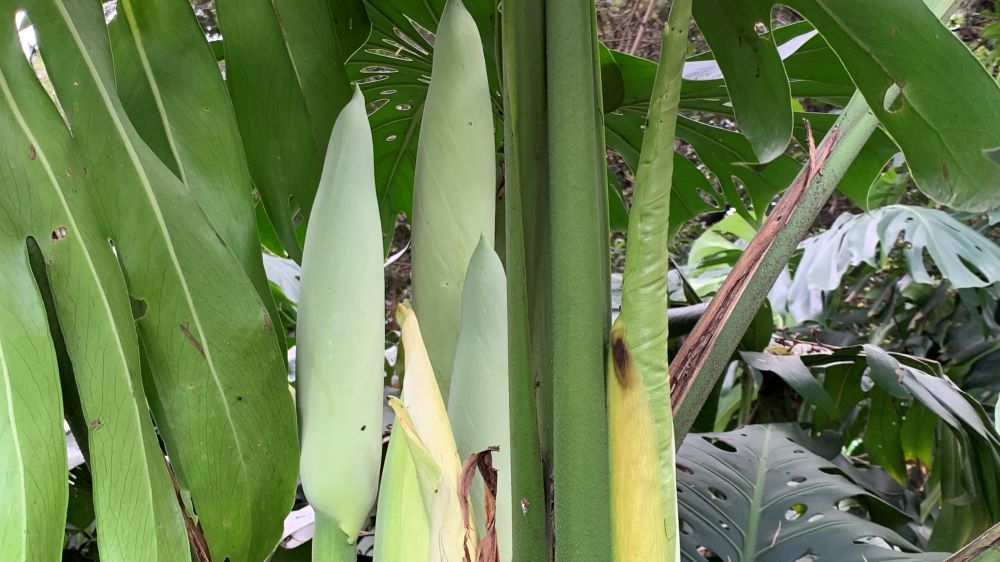
9. Provide Support
To support your Monstera outside in summer, you can use a trellis or stake. You can also use a moss pole, which is a pole covered in sphagnum moss that helps to retain moisture and provide support for the plant. This will help the plant climb and grow upward.
When using a support structure, be sure to tie the stems loosely to the structure with soft twine or plant ties. This will prevent damage to the stems and allow the plant to grow naturally.

How to Protect Monstera Deliciosa Outdoors in Summer
Here are my top tips to protect your monstera deliciosa when planting them outside in summer.
1. Provide shade
Shade is the most important factor to get your outdoor monstera deliciosa growing well in summer. Their leaves will be sensitive to the hottest sun and they can become burnt. Indoor monstera will need full shade when they are moved outdoors.
If you plan to leave your monstera outdoors them choose a position that is shaded by a nearby tree. Our monstera is planted under a giant bird of paradise so it gets shade almost all day. Nearby buildings, shade houses and verandahs are all great ways to shade your monstera in the afternoons in summer.
2. Water regularly
Monstera planted outside will need regular water over the summer. Water the plant deeply and allow it to dry out between watering. If you have low rainfall over summer then it will be essential to check them regularly and top them up with water when they start to dry out. Water your plants once per week in dry areas if you are not getting enough rain.
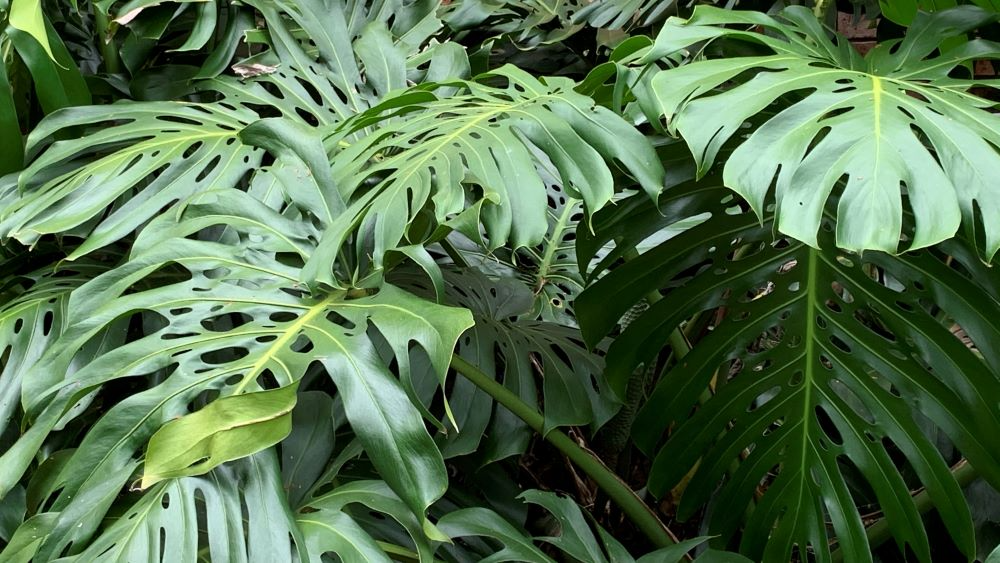
3. Leave damaged leaves on until fall
If your monstera deliciosa does get damaged by sunburn then it is best to leave the damaged leaves on the plant until the weather cools. Burnt leaves will often turn brown on the edges but the rest of the leaf can remain green and they will protect the lower leaves.
When the weather cools in fall, you can remove the leaves and allow space for the new ones to grow. Trim them off down to the main stem to tidy up the plant and throw them in the compost.
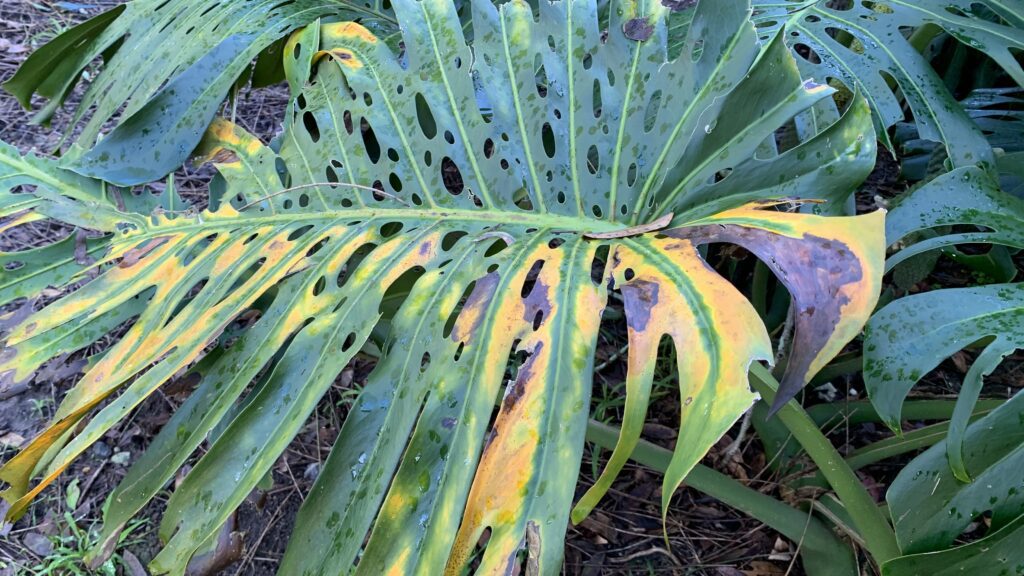
4. Plant into good quality soil
If you are planting monstera outdoors then it is important to make sure have well draining soil. Improve the clay or sandy soil types with aged cow manure, compost and worm castings before planting the monstera into the ground. Dig the ingredients through to improve drainage and allow the root system to grow deep.
This will help to protect the plant during hot weather and prevent the plant from developing root rot.
5. Add mulch
Add a good layer of mulch around the base of the monstera plant. Layer 2-3 inches of bark mulch around the root zone to keep water in, prevent weeds and help to prevent soil and disease from splashing on the leaves when watering.

6. Manage pests and diseases
Growing Monstera Deliciosa outside in summer can be a challenge due to the potential for pests and diseases. Here are some tips to help you manage these issues:
- Spider mites: These pests can drain your Monstera plant of its chlorophyll, causing small white spots or stipples to appear on the leaves. Over time, the leaves will turn yellow and then brown as the mites continue to feed. To get rid of spider mites, you can use insecticidal soap or Neem oil. Be sure to follow the instructions carefully and apply the treatment consistently.
- Mealybugs: Another common pest that can attack your Monstera plant is mealybugs. These insects are small and white, and they can be found on the leaves and stems. They feed on the sap of the plant, causing it to weaken and become susceptible to other diseases. To get rid of mealybugs, you can use rubbing alcohol or a mixture of water and dish soap. Apply the treatment to the affected areas and repeat as necessary.
- Root rot: This disease can occur when the soil is too wet or when the drainage is poor. The roots of the plant will begin to rot, and the leaves will turn yellow and wilt. To prevent root rot, make sure that the soil is well-draining and that you are not overwatering your Monstera plant. If you suspect root rot, you may need to repot the plant in fresh soil and cut away any damaged roots.
- Leaf spot: This disease can be caused by a variety of fungi, and it can appear as small brown or black spots on the leaves. To prevent leaf spot, make sure that your Monstera plant is not overcrowded and that there is good air circulation around the leaves. If you notice leaf spot, you may need to remove the affected leaves and treat the plant with a fungicide.
Frequently Asked Questions
Can I put my Monstera outside in summer?
Indoor monstera plants can be moved outside if they are placed in a protected area. Keep them out of direct sun for the first 2-3 weeks and then gradually move them into a spot that gets morning bright light. This will allow the large leaves to photosynthesize.
You can leave your monstera outdoors in tropical areas throughout the year as long as it is protected from the afternoon summer sun and cold winter temperatures. Planting them near a masonry wall is a great way to protect your plant.
Can Monstera Deliciosa become invasive when planted outside?
Monstera deliciosa can become invasive when planted outdoors in regions with tropical or subtropical climates where it can grow and reproduce rapidly. While it is not considered a highly invasive species in most regions, it has the potential to naturalize and spread regions with climates similar to its native habitat in Central America, such as parts of Florida, Hawaii, some Caribbean islands
If Monstera are planted in outdoor gardens or near natural areas it can potentially establish itself in nearby landscapes, including forests, where it could compete with native vegetation. If you live in an area where Monsteras grow rapidly or could become invasive, plant them in pots and monitor them closely.
Do monsteras like hot weather?
Monstera plants like hot, humid weather and thrive in a warm climate. If you get lots of summer rain and have few frosts monstera will grow great outdoors. Protect them from afternoon sun by providing them with shade from nearby trees or structures.
How hot is too hot for Monstera?
Monstera plants can handle can hot temperatures up to 85° Fahrenheit if they are protected from direct sunlight and are watered well. If you know that a hot day is coming, water your monstera at the ground level in the morning.
How much sunlight does Monstera Deliciosa need when grown outside?
Monstera Deliciosa needs indirect but bright light when grown outside. Aim to give it around 5-8 hours of light per day. If you have a variegated variety of Monstera, it will need more light to develop the colors in its leaves. Aim to give variegated monsteras 5-12 hours of light per day.
What are some common pests and diseases that affect Monstera Deliciosa when grown outside?
Some common pests that affect Monstera Deliciosa when grown outside include spider mites, mealybugs, and scale insects. These pests can cause damage to the leaves and weaken the plant. To prevent infestations, you should inspect your plant regularly and treat any problems as soon as they arise.
How often should I water Monstera Deliciosa when grown outside in summer?
You should water Monstera Deliciosa when the top inch of soil feels dry to the touch. In summer, you may need to water it more frequently to prevent the soil from drying out completely. However, be careful not to overwater it, as this can cause root rot and other problems.
What are some signs that my Monstera Deliciosa is not doing well when grown outside in summer?
Some signs that your Monstera Deliciosa is not doing well when grown outside in summer include yellowing or browning of the leaves, wilting, and stunted growth. These symptoms may indicate that your plant is not getting enough water, nutrients, or light, or that it is suffering from pests or diseases.
Summary
Monstera deliciosa are easy to grow outdoors if you have a position that is protected from afternoon sun. Water them regularly and remove any damaged leaves after summer has finished. Large sunburnt leaves will protect the new growth from damage. Trim off old leaves when fall arrives and your monstera will look fresh and healthy.
I am an accredited practicing dietitian, experienced gardener and a dedicated cook. I love writing and sharing my experience so you can learn from my successes and mistakes.
